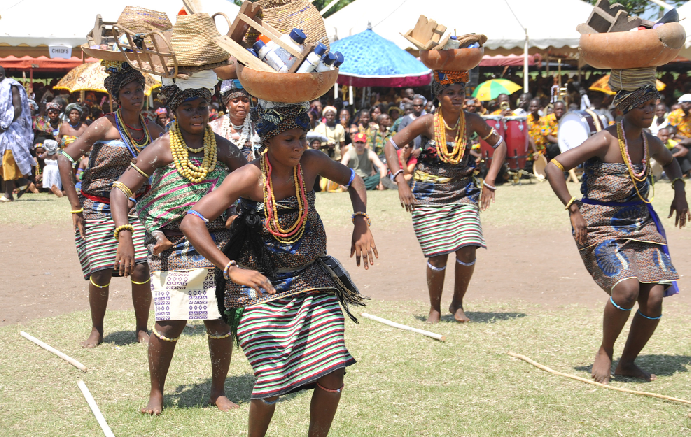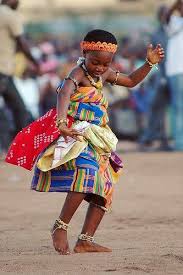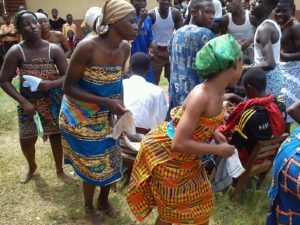
By Sheila A. Williams
Often, there is no distinction made about what is considered an African dance. Dance forms in Africa have been largely classified into one type of dance but the truth is that dance in Africa varies from country to country, tribe to tribe and has a vast significance.
How can the beauty of culture and tradition be caught in the moment of a dance? Well, many Africa cultures, traditions of past and present, are proven by storytelling and also often by dance.
The preservation of culture is important because culture is the heart and soul of people. Unless you want to lose your identity or who you are, you will value your culture.
Dance forms an integral part of all vital facets of the life cycle. We dance during childbirth, naming ceremonies, puberty rites, marriage, religious ceremonies, festivals, funerals, etc. Dance teaches customs and history.
The Adowa Dance
 The Ashanti Kingdom is one of the many groups of people found in Ghana – the traditional dance of the Ashanti people of Ghana is Adowa.
The Ashanti Kingdom is one of the many groups of people found in Ghana – the traditional dance of the Ashanti people of Ghana is Adowa.
This dance is especially noted for the grace and complexity of the dancers’ movements. The drumming is also noted for the complexity of the interlocking rhythms and the two atumpan drums which are used as the lead or master drum. The Adowa dance is the most widespread and most frequently performed social musical type of the Akan speaking people of Ghana.
Story behind Adowa Dance
The story behind the dance states that there was a once a queen mother in Ashanti called Abrewa Tutuwa. She suddenly fell ill in the cause of her reign. The Obosom (god) was consulted and a request for a live antelope was to be used for the sacrificial rites. It was alleged that, the asafo companies were promptly detailed to the forest to look for the animal. On coming back, the people saw to their amazement the antelope jumping and making very strange movements. The dance originated through the movements made by the antelope, hence the name given to it….ADOWA
Skills & Steps in Adowa Dance
The Adowa dance combines sign language, which is used to tell a story. The different movements of the hands tell their own story, in their way.
Adowa is largely performed during funerals, yearly festivals, durbar of chiefs, visit of international dignitaries, etc., and is usually led by a female known as Adowahemma.
Agbadza Dance
The traditional dance of the Eʋe (Ewe or Eve) people of the Volta Region of Ghana Ghana. It is characterized by the graceful choreograph of a couple seasoned with the rhythmic movement of the arms, the waist and the feet in perfect synchrony.
It is particularly performed during the Hogbetsosto Festival, a celebration by the Anlo Ewe people.
Agbadza is traditionally a war dance but is now used in social and recreational situations to celebrate peace. War dances are sometimes used as military training exercises, with signals from the lead drum ordering the warriors to move ahead, to the right, go down, etc. These dances also helped in preparing the warriors for battle and upon their return from fighting they would act out their deeds in battle through their movements in the dance.
The Agbadza dance is usually played at funerals, weddings, naming ceremonies and parties. It is played at any occasion that calls for an Ewe identity. This music is known by other ethnic groups to be uniquely Ewe.
Everyone is welcome to join in the dance, unlike other Ewe dances, which sometimes are reserved for people of a certain age, religion and gender.
Today, Agbadza is the most famous and widely played Ewe dance in Ghana and in other countries.
Atsiagbekor Dance
This contemporary version of the Ewe war dance Atamga (Great (ga) Oath (atama)) in reference to the oaths taken by people before proceeding into battle. The movements of this present-day version are mostly in platoon formation and are not only used to display battle tactics, but also to energize and invigorate the soldiers.
Today, Atsiagbekor is performed for entertainment at social gatherings and at cultural presentations. Atsia dance is performed mostly by women, and it’s a series of stylistic movements dictated to dancers by the lead drummer. Each dance movement has its own prescribed rhythmic pattern, which is synchronized with the lead drum.
‘Atsia’ in the Ewe language means style or display.
Bɔbɔɔbɔ Dance
 It is pronounced Borborbor, the Ewe-speaking people in the central and northern parts of the Volta Region of Ghana cultivate the Bɔbɔɔbɔ dance. Bɔbɔɔbɔ (originally ‘Akpese’) might have originated in the Kpando area, and is said to have been created by the late Mr. Francis Kojo Nuadro. He is thought to have been an ex-police officer who returned to Kpando and organized a group in the middle to late 1940s. The dance has its roots in the ‘Highlife’ popular music of Ghana and other West African countries.
It is pronounced Borborbor, the Ewe-speaking people in the central and northern parts of the Volta Region of Ghana cultivate the Bɔbɔɔbɔ dance. Bɔbɔɔbɔ (originally ‘Akpese’) might have originated in the Kpando area, and is said to have been created by the late Mr. Francis Kojo Nuadro. He is thought to have been an ex-police officer who returned to Kpando and organized a group in the middle to late 1940s. The dance has its roots in the ‘Highlife’ popular music of Ghana and other West African countries.
Bɔbɔɔbɔ gained national recognition in the 1950s and 1960s because of its use at political rallies and the novelty of its dance formations and movements.
It is generally performed at funerals and other social occasions. This is a social dance with a great deal of room for free expression. In general, the men sing and dance in the centre while the women dance in a ring around them.
Types of Borborbor Dance
There are two types; the ‘slow’ and ‘fast’ versions of Bɔbɔɔbɔ; the fast Bɔbɔɔbɔ is believed to come from the Kpando area and the slow version from Hohoe.
The slow one is called Akpese and the fast one is termed to be Bɔbɔɔbɔ. The Lolobi’s in Kumasi are known for doing a particular fast version of the slow version.
Kpanlongo Dance
Mostly performed by the Ga people of Ghana. It is often referred to as “the dance of the youth.”
Kpanlongo started during the wake of Ghana’s Independence as a musical type for entertainment in Accra. Kpanlongo is presently performed at life-cycle events, festivals, and political rallies.
Bamaya Dance
It is performed by the Northern people of Ghana. It narrates the legend of a time of great drought in the northern part of Ghana.
Story behind Bamaya Dance
An oracle told the people that the drought was brought about by the manner in which the men were severely repressing and demeaning the women. It further stated that the drought would be relieved only when the men lowered themselves to the role they were imposing on the women by putting on skirts and participating in this dance. When the men did this it began to rain.
It is currently performed during harvest time in northwestern Ghana by both Dagbani men and women.
Klama Dance
This dance is associated with puberty rites of the Krobo people of Ghana. It emphasizes the graceful movement of hands and feet. With small rhythmic steps and heads turned demurely downward, the dancers embody quiet elegance.
The different movements of the dance are designed to reveal the beauty of the dancers. Suitors watching from the sidelines will often approach a girl’s family after the ceremony and make an offer for her hand in marriage.
Personal Connection and Vibration
“I enjoy dancing, because it has a deep meaning and a spiritual connection with the Ancestors.” This is a line from a dance instructor of an Ewe culture troupe in Accra New Town.
Master dancers and drummers are particular about the learning of the dance exactly as taught. Children and other adults must learn the dance exactly as taught without variation. Improvisation or a new variation comes only after mastering the dance, performing, and receiving the appreciation of spectators and the sanction of village elders and guests at various event grounds.
The traditional drumming and dancing, cheering crowds, palanquins in different shapes and sizes and singing of traditional war songs, combine to make reliving the beautiful culture worth preserving of Ghanaians through dancing.
Do make it a point to join the people of Anlo, Ga, Ashanti, Krobo and the Northerners any time this year, for a treasured display of their unique rich cultural dance.
Writers e-mail: eyram.williamsgh@gmail.com




























